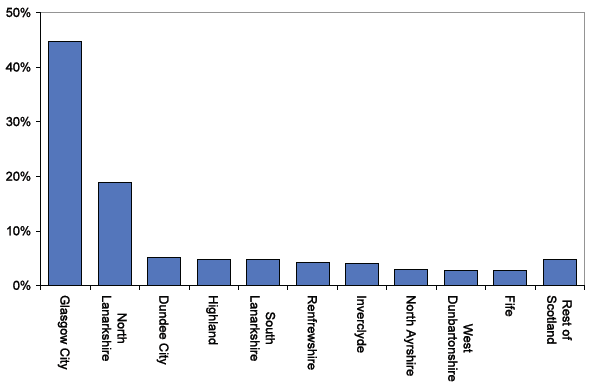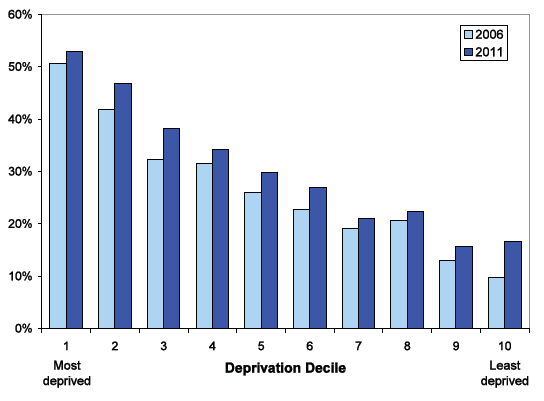Scottish Vacant and Derelict Land Survey 2011
Survey of vacant and derelict land in Scotland.
5 Derelict and Urban Vacant Land: The Location of such land relative to Deprivation
5.1 This section focuses on derelict and urban vacant land and where it is situated relative to the 15% most deprived datazones in Scotland (as identified by the 'Scottish Index of Multiple Deprivation' (SIMD 2009, Version 2)). The SIMD identifies small area concentrations of multiple deprivation across all of Scotland. It contains 38 indicators in seven domains: Current Income, Employment, Health, Education, Skills and Training, Geographic Access to Services, Housing and Crime. SIMD 2009 was published in October 2009 with a version 2 revision in July 2010 and updates the SIMD produced in 2006.
Table 9: Derelict and Urban Vacant land located within the 15% most deprived datazones, 2007-20111,2,3,4,5
| 2007 | 2008 | 2009 | 2010 | 2011 | |||||||
|---|---|---|---|---|---|---|---|---|---|---|---|
| Local Authority | % of LA Datazones within Scotland's 15% most deprived (SIMD, 2009 V2) | Area of Vacant & Derelict Land (Hectares) | Sites | Area of Vacant & Derelict Land (Hectares) | Sites | Area of Vacant & Derelict Land (Hectares) | Sites | Area of Vacant & Derelict Land (Hectares) | Sites | Area of Vacant & Derelict Land (Hectares) | Sites |
| Aberdeen City | 11 | 4 | 2 | 4 | 2 | 4 | 2 | 5 | 4 | 8 | 6 |
| Aberdeenshire | 1 | 3 | 5 | 3 | 5 | 3 | 6 | 3 | 5 | 7 | 7 |
| Angus | 4 | - | - | - | - | - | - | - | - | - | - |
| Argyll & Bute | 8 | 5 | 12 | 5 | 12 | 5 | 9 | 2 | 7 | 3 | 7 |
| Clackmannanshire | 19 | 12 | 8 | 12 | 8 | 8 | 5 | 2 | 3 | 2 | 2 |
| Dumfries & Galloway | 6 | * | 1 | - | - | - | - | - | - | - | - |
| Dundee City | 30 | 97 | 114 | 88 | 104 | 85 | 101 | 92 | 98 | 89 | 91 |
| East Ayrshire | 18 | 6 | 9 | 6 | 9 | 6 | 11 | 6 | 11 | 7 | 13 |
| East Dunbartonshire | 3 | 1 | 2 | 1 | 1 | 1 | 1 | 1 | 1 | 1 | 1 |
| East Lothian | 3 | - | - | - | - | - | - | - | - | - | - |
| East Renfrewshire | 4 | 3 | 4 | 1 | 3 | * | 1 | * | 1 | * | 1 |
| Edinburgh, City of | 11 | 41 | 11 | 29 | 8 | 27 | 9 | 26 | 10 | 25 | 10 |
| Eilean Siar | - | - | - | - | - | - | - | - | - | - | - |
| Falkirk | 9 | 3 | 3 | 4 | 4 | 3 | 3 | * | 3 | 1 | 3 |
| Fife | 11 | 50 | 28 | 51 | 29 | 50 | 25 | 46 | 20 | 47 | 22 |
| Glasgow City | 44 | 771 | 514 | 823 | 573 | 839 | 579 | 805 | 576 | 787 | 580 |
| Highland | 6 | 92 | 32 | 93 | 33 | 92 | 34 | 86 | 32 | 86 | 33 |
| Inverclyde | 38 | 75 | 93 | 72 | 85 | 70 | 87 | 69 | 85 | 70 | 82 |
| Midlothian | 4 | * | 1 | - | - | - | - | - | - | - | - |
| Moray | 1 | - | - | - | - | - | - | - | - | - | - |
| North Ayrshire | 24 | 55 | 47 | 61 | 50 | 55 | 48 | 54 | 46 | 53 | 45 |
| North Lanarkshire | 21 | 392 | 75 | 407 | 83 | 385 | 95 | 385 | 95 | 334 | 91 |
| Orkney Islands | - | - | - | - | - | - | - | - | - | - | - |
| Perth & Kinross | 3 | 1 | 1 | 1 | 1 | 1 | 1 | 1 | 1 | 1 | 1 |
| Renfrewshire | 20 | 65 | 51 | 60 | 49 | 74 | 63 | 74 | 64 | 74 | 64 |
| Scottish Borders | 4 | - | - | - | - | - | - | - | - | - | - |
| Shetland Islands | - | - | - | - | - | - | - | - | - | - | - |
| South Ayrshire | 12 | 8 | 7 | 8 | 7 | 8 | 9 | 8 | 9 | 8 | 8 |
| South Lanarkshire | 15 | 64 | 41 | 71 | 36 | 78 | 47 | 73 | 48 | 84 | 54 |
| Stirling | 6 | 8 | 4 | 7 | 3 | 12 | 5 | 12 | 5 | 12 | 5 |
| West Dunbartonshire | 26 | 44 | 31 | 27 | 22 | 45 | 32 | 46 | 33 | 51 | 35 |
| West Lothian | 9 | 8 | 6 | 10 | 7 | 10 | 7 | 36 | 7 | 10 | 7 |
| Scotland | 15 | 1,807 | 1,102 | 1,843 | 1,134 | 1,864 | 1,180 | 1,835 | 1,164 | 1,760 | 1,168 |
1. Figures may not sum due to rounding.
2. 2007-2011 analysis uses the results of the SIMD 2009 Version 2 General Report, revised in July 2010.
3. See Annex Table E for details of council participation in different years.
4. Further information on how this data was calculated is available in Annex Section A.8
5. During 2011, historical data for the years 2005-2010 were revised to remove sites that had been taken out of the survey for definitional reasons and to correct any revisions to the data highlighted in the 2011 survey returns. Further information on this process is available in the Annex along with un-amended historical data for the survey years of 1996-2004.
5.2 Table 9 shows the proportion of each local authority's datazones that are within Scotland's 15% most deprived and the amount of derelict and urban vacant land that is situated within those datazones for the years 2007-2011. In 2007, 1,807 hectares of derelict and urban vacant land were situated within the 15% most deprived datazones. By 2011 this had decreased slightly to 1,760 hectares after peaking at 1,864 hectares in 2009. This represents 16% of all derelict and urban vacant land recorded in Scotland in 2011.
5.3 Glasgow City has the largest amount of derelict and urban vacant land located within the 15% most deprived datazones for each of the last 5 years. This figure has increased by 16 hectares between 2007 and 2011 from 771 hectares to 787 hectares, although it peaked in 2009 at 839 hectares. North Lanarkshire has the second highest amount of derelict and urban vacant land located within the 15% most deprived datazones for 2007-2011. This figure has dropped by 58 hectares between 2007 and 2011 from 392 hectares to 334 hectares and down from the peak in 2008 of 407 hectares.
5.4 At the other end of the scale, Eilean Siar, Orkney Islands and Shetland Islands have no datazones within Scotland's 15% most deprived, thus no derelict or urban vacant land could be recorded in Table 9. In addition to this, whilst Angus, East Lothian, Moray and Scottish Borders do have datazones within Scotland's 15% most deprived, they do not have any derelict or urban vacant land situated within those areas.
Chart 3: Percentage of Derelict and Urban Vacant land located within the 15% most deprived datazones, 2011

5.5 Chart 3 shows the amount of derelict and urban vacant land located within the 15% most deprived datazones in 2011, split by local authority. Glasgow City has the highest proportion, with 45% of all derelict and urban vacant land within the 15% most deprived datazones being located within this council's boundaries. North Lanarkshire is second, containing 19% of all derelict and urban vacant land located within the 15% most deprived datazones. Some distance behind those 2 councils lie Dundee City (5%), Highland (5%), South Lanarkshire (5%), Renfrewshire (4%) and Inverclyde (4%). Across Scotland as a whole, almost two thirds of all derelict and urban vacant land located within the 15% most deprived datazones are in either Glasgow City or North Lanarkshire.
5.6 Chart 4 draws together the analysis on people's proximity to derelict land in 2006/2011 and the information on deprivation levels contained within SIMD 2009 Version 2. Each deprivation decile is shown on the x-axis, whereby '1' represents the 10% most deprived datazones in Scotland, through to '10', which represents the 10% least deprived datazones in Scotland. For each decile, the proportion of the total datazone population that lives within 500m of a derelict site in 2006 and 2011 is given.
5.7 A clear relationship can be seen in Chart 6, whereby as datazones get progressively less deprived, the proportion of their population that lives within 500m of a derelict site becomes smaller. This relationship holds for both 2006 and 2011. Between 2006 and 2011 the total amount of derelict land has reduced by almost 0.5%. The chart shows that there are increases in the percentages of Scotland's population living within 500m of derelict land across all deprivation deciles.
Chart 4: Percentage of Scotland's population living within 500m of Derelict land by deprivation decile, 2006 & 2011

Contact
Email: Dorothy Watson
There is a problem
Thanks for your feedback